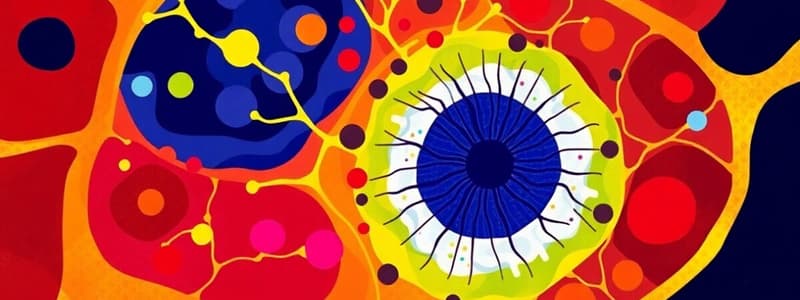Podcast
Questions and Answers
विशिष्ट कोशिकाए किस प्रकार की कार्यों के लिए अनुकूलित होती हैं? उदाहरण दें।
विशिष्ट कोशिकाए किस प्रकार की कार्यों के लिए अनुकूलित होती हैं? उदाहरण दें।
विशिष्ट कोशिकाएँ जैसे तंत्रिका कोशिकाएँ, पेशी कोशिकाएँ, और रक्त कोशिकाएँ विशेष कार्यों के लिए अनुकूलित होती हैं।
कोशिका चक्र में किन मुख्य चरणों का समावेश होता है और उनका महत्व क्या है?
कोशिका चक्र में किन मुख्य चरणों का समावेश होता है और उनका महत्व क्या है?
कोशिका चक्र में इंटर्फेज (विकास और DNA पुनरावृत्ति) और विभाजन चरण (माइटोसिस/मायोसिस) शामिल होते हैं। यह कोशिका वृद्धि, मरम्मत और प्रजनन सुनिश्चित करता है।
कोशिकाओं के बीच संचार क्यों महत्वपूर्ण है?
कोशिकाओं के बीच संचार क्यों महत्वपूर्ण है?
कोशिकाओं के बीच संचार विकास, होमियोस्टेसिस और उत्तेजनाओं के प्रति प्रतिक्रिया के लिए आवश्यक है।
कोशिका चयापचय में क्या शामिल होता है और यह क्यों महत्वपूर्ण है?
कोशिका चयापचय में क्या शामिल होता है और यह क्यों महत्वपूर्ण है?
प्रोग्रामेड कोशिका मृत्यु (अपोप्टोसिस) और निराचारिता (नेक्रोसिस) के बीच क्या अंतर है?
प्रोग्रामेड कोशिका मृत्यु (अपोप्टोसिस) और निराचारिता (नेक्रोसिस) के बीच क्या अंतर है?
कोशिका की संरचना में किन तीन मुख्य घटकों का समावेश होता है?
कोशिका की संरचना में किन तीन मुख्य घटकों का समावेश होता है?
प्रोकैरियोटिक कोशिकाएँ और युकैरियोटिक कोशिकाएँ में क्या मुख्य अंतर है?
प्रोकैरियोटिक कोशिकाएँ और युकैरियोटिक कोशिकाएँ में क्या मुख्य अंतर है?
माइटोकॉन्ड्री का मुख्य कार्य क्या है?
माइटोकॉन्ड्री का मुख्य कार्य क्या है?
प्लाज्मा मेम्ब्रेन की संरचना क्या होती है और इसका क्या कार्य है?
प्लाज्मा मेम्ब्रेन की संरचना क्या होती है और इसका क्या कार्य है?
गोल्ज़ी apparatus का कार्य क्या है?
गोल्ज़ी apparatus का कार्य क्या है?
क्रियात्मक कोशिकाओं में लायसोसोम का क्या कार्य है?
क्रियात्मक कोशिकाओं में लायसोसोम का क्या कार्य है?
साइटोप्लाज्म क्या है और यह कोशिका के लिए क्यों महत्वपूर्ण है?
साइटोप्लाज्म क्या है और यह कोशिका के लिए क्यों महत्वपूर्ण है?
कोशिकाओं में विविधता के क्या पहलू होते हैं?
कोशिकाओं में विविधता के क्या पहलू होते हैं?
Flashcards
कोशिका जीव विज्ञान क्या है?
कोशिका जीव विज्ञान क्या है?
कोशिका जीव विज्ञान जीव विज्ञान की वह शाखा है जो कोशिकाओं का अध्ययन करती है - उनके शारीरिक गुण, उनकी संरचना, उनमें मौजूद अंगक, उनके पर्यावरण के साथ बातचीत, उनके जीवन चक्र, मृत्यु और प्रजनन।
कोशिकाओं की बुनियादी इकाई क्या है?
कोशिकाओं की बुनियादी इकाई क्या है?
सभी जीवित जीवों में, कोशिकाएं जीवन की मूलभूत इकाइयाँ होती हैं।
प्रोकैरियोटिक कोशिकाएं क्या हैं?
प्रोकैरियोटिक कोशिकाएं क्या हैं?
प्रोकैरियोटिक कोशिकाएँ (बैक्टीरिया और आर्किया) सरल होती हैं, जिनमें झिल्ली से बंधे हुए अंगक नहीं होते हैं।
यूकैरियोटिक कोशिकाएँ क्या हैं?
यूकैरियोटिक कोशिकाएँ क्या हैं?
Signup and view all the flashcards
प्लाज्मा झिल्ली क्या करती है?
प्लाज्मा झिल्ली क्या करती है?
Signup and view all the flashcards
कोशिका द्रव्य क्या है?
कोशिका द्रव्य क्या है?
Signup and view all the flashcards
नाभिक का कार्य क्या है?
नाभिक का कार्य क्या है?
Signup and view all the flashcards
माइटोकॉन्ड्रिया का काम क्या है?
माइटोकॉन्ड्रिया का काम क्या है?
Signup and view all the flashcards
कोशिका झिल्ली की संरचना क्या है?
कोशिका झिल्ली की संरचना क्या है?
Signup and view all the flashcards
कोशिका झिल्ली का कार्य क्या है?
कोशिका झिल्ली का कार्य क्या है?
Signup and view all the flashcards
विशेषीकृत कोशिकाएँ
विशेषीकृत कोशिकाएँ
Signup and view all the flashcards
कोशिका चक्र
कोशिका चक्र
Signup and view all the flashcards
माइटोसिस
माइटोसिस
Signup and view all the flashcards
मायोसिस
मायोसिस
Signup and view all the flashcards
कोशिका संचार
कोशिका संचार
Signup and view all the flashcards
कोशिकीय चयापचय
कोशिकीय चयापचय
Signup and view all the flashcards
प्रोग्राम की गई कोशिका मृत्यु (एपोप्टोसिस)
प्रोग्राम की गई कोशिका मृत्यु (एपोप्टोसिस)
Signup and view all the flashcards
नेक्रोसिस
नेक्रोसिस
Signup and view all the flashcards
Study Notes
Introduction to Cell Biology
- Cell biology is the branch of biology that studies cells—their physiological properties, their structure, the organelles they contain, interactions with their environment, their life cycle, death, and reproduction.
- Cells are the basic units of life in all living organisms.
- The study of cells fundamentally impacts virtually all areas of biology, from understanding basic molecular mechanisms to more complex systems biology applications such as organ development and disease.
Cell Structure
- All cells share fundamental characteristics, including a plasma membrane, cytoplasm, and genetic material (DNA).
- Prokaryotic cells (bacteria and archaea) are simpler, lacking membrane-bound organelles.
- Eukaryotic cells (plants, animals, fungi, and protists) are more complex, containing membrane-bound organelles like the nucleus, mitochondria, and endoplasmic reticulum.
- The plasma membrane is a selectively permeable barrier that regulates the passage of substances into and out of the cell.
- The cytoplasm is the jelly-like substance that fills the cell, containing various organelles and the cytoskeleton.
- The cytoskeleton provides structural support and facilitates cell movement.
Organelles
- Nucleus: Contains the cell's genetic material (DNA) and controls cellular activities.
- Mitochondria: The "powerhouses" of the cell, responsible for energy production through cellular respiration.
- Endoplasmic reticulum (ER): A network of membranes involved in protein synthesis, lipid metabolism, and calcium storage.
- Golgi apparatus: Processes and packages proteins and lipids for secretion or intracellular use.
- Lysosomes: Contain enzymes that break down cellular waste and foreign material.
- Vacuoles: Storage compartments for water, nutrients, and waste products (especially prevalent in plant cells).
- Ribosomes: Sites of protein synthesis.
- Peroxisomes: Involved in various metabolic processes, including detoxification.
Cell Membrane
- The cell membrane is a phospholipid bilayer with embedded proteins.
- Its structure allows for selective permeability, controlling what enters and leaves the cell.
- It plays a vital role in cell signaling and communication.
- Membrane proteins include integral (spanning the membrane) and peripheral (associated with the membrane surface).
Cell Diversity
- Cells exhibit remarkable diversity in size, shape, and function.
- Specialized cells are adapted to perform specific tasks in multicellular organisms.
- Examples include nerve cells, muscle cells, and blood cells.
Cell Cycle and Reproduction
- The cell cycle is a series of events that leads to cell growth and division.
- The cycle includes interphase (growth and DNA replication) and mitotic/meiotic phases (nuclear division).
- Cell division ensures growth, repair, and reproduction.
- Mitosis is responsible for producing identical daughter cells, while meiosis produces genetically diverse gametes (sex cells) essential for sexual reproduction.
Cell Communication
- Cells communicate with each other to coordinate activities in multicellular organisms.
- Communication involves various mechanisms, including direct contact, signal transduction pathways, and chemical signals.
- This communication is crucial for development, homeostasis, and response to stimuli.
Cellular Metabolism
- Cellular metabolism encompasses all biochemical reactions within a cell.
- It involves energy production, nutrient utilization, synthesis of biomolecules, and waste disposal.
- Metabolic pathways are interconnected and tightly regulated.
Cell Death
- Programmed cell death (apoptosis) is a controlled process essential for development and tissue homeostasis.
- Necrosis is an uncontrolled cell death, often a result of injury or disease.
Studying That Suits You
Use AI to generate personalized quizzes and flashcards to suit your learning preferences.




